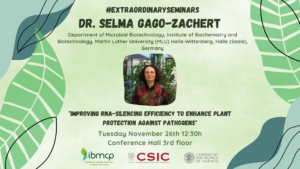We are excited to announce an upcoming seminar that will spotlight the innovative intersection of artificial intelligence (AI) and agricultural science. Join us on Friday, February 23rd, at 12:30 PM in the Conference Hall located on the 3rd floor of the IBMCP for presentation by Dr. María José Aranzana from the Centre for Research in Agricultural Genomics (CRAG) CSIC-IRTA-UAB-UB.
Dr. Aranzana, will delve into the topic of “AI-based tools for fruit tree breeding”, exploring how cutting-edge AI technologies are revolutionizing the way we approach fruit tree breeding.

Crop improvement has significantly advanced over the past decades due to the shift from traditional breeding, exclusively dependent on phenotypic information, to decisions informed by genetic data. This progress has been recently accelerated thanks to high-throughput phenotyping platforms and the modernization of phenotyping techniques such as the utilization of drones and robots in the field coupled with machine learning image processing and analysis. We have contributed to this field with the development of AI-based tools to evaluate fruit shape and size from images (Shape Analyzer), and with a model to track leaves along plant growth while acquiring relevant data for leaf photosynthetic capacity (LeTra).
While phenotyping tools have advanced rapidly, genetic tools have not lagged behind. All of this contributes to the generation of a vast amount of data that must be analyzed and interrelated.In plant breeding, few molecular markers that detect genetic variants associated with traits controlled by major genes are used to select new individuals without the need to observe their phenotype. In the case of complex traits, the use of a greater number of markers and statistical models is usually required to predict the behavior of new individuals. However, these methods have limitations associated with the distribution of phenotypic variables (in the case of linear models) or the required specifications of Bayesian models. To overcome these limitations, we have built a prediction model based on convolutional neural networks (CNN), GenoDrawing, capable of predicting and generating apple images from a reduced matrix of SNP markers. A similar strategy could be used to predict other hereditary traits of greater agricultural or economic relevance, such as fruit color or severity of symptoms caused by pests and diseases in specific genotypes.
If anyone is interested in meeting with the speaker, please contact Antonio Monforte (amonforte@ibmcp.upv.es).





